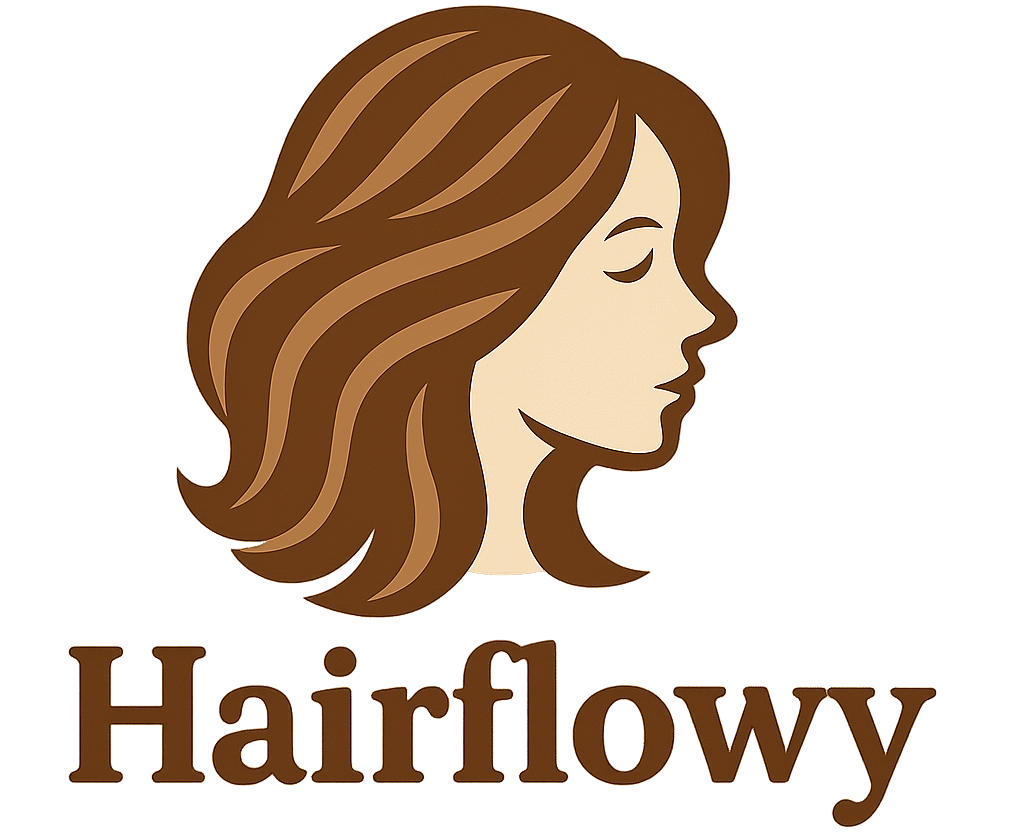Fine hair doesn’t mean you can’t rock a stunning bob! We’ve discovered that the right bob cut can transform thin strands into a voluminous masterpiece that’ll have everyone asking about your secret. The key lies in choosing styles that create the illusion of thickness while maintaining that chic, effortless look we all crave.
We understand the struggle of fine-haired beauties who’ve been told their options are limited. That’s simply not true. From textured lobs to layered pixie bobs, there’s a perfect cut waiting to unleash your hair’s hidden potential. The right bob can add movement, body and that coveted bounce that makes fine hair look incredibly full.
Our carefully curated list of bob hairstyles specifically targets the unique needs of fine hair. We’ll show you exactly which cuts work best, why they’re so effective and how to style them for maximum impact. Get ready to fall in love with your hair all over again.
Textured Bob With Layers for Added Volume
Adding strategic layers to your bob creates the illusion of fullness that fine hair craves. This technique transforms limp strands into a voluminous masterpiece through carefully placed cuts and expert styling methods.
Strategic Layer Placement for Fine Hair
Positioning layers correctly makes all the difference for fine hair volume. We recommend starting layers about 2-3 inches from your crown rather than at the very top, which prevents the dreaded flat appearance. Long layers work better than short choppy ones because they maintain weight while creating movement.
Focus on face-framing pieces to draw attention upward and outward. These shorter sections around your cheekbones and jawline add instant dimension without sacrificing overall length. Professional stylists often cut these pieces at a 45-degree angle to create natural-looking graduation.
Avoid over-layering your hair since too many cuts can make fine strands appear thinner. We suggest limiting layers to 2-3 distinct levels throughout your bob. This approach maintains enough hair density while still achieving that coveted textured look.
Consider asymmetrical layering for added visual interest. Slightly longer pieces on one side create an edgy, modern appearance while the varied lengths trick the eye into seeing more volume than actually exists.
Styling Tips for Maximum Body
Start with volumizing products applied to damp hair before any heat styling. We love lightweight mousses and root-lifting sprays that won’t weigh down fine strands. Apply these products from mid-length to ends, avoiding the scalp area completely.
Use a round brush while blow-drying to lift hair away from your head. Wrap small sections around a 2-inch barrel brush and direct airflow from roots to tips. This technique creates lift at the crown while smoothing the hair cuticle for extra shine.
Incorporate texturizing spray after styling to enhance the layered effect. These products add grip and separation between strands, making your textured bob appear fuller and more defined. Scrunch the spray into your hair with your fingers for best results.
Try the upside-down blow-dry method for extra root volume. Flip your head forward and direct the dryer upward toward your scalp for the first few minutes of drying. This approach encourages hair to lift away from your head naturally.
Finish with strategic teasing at the crown using a fine-tooth comb. Gently backcomb small sections near your part line, then smooth the top layer over the teased area. This creates lasting height without looking overdone.
Inverted Bob for Instant Fullness
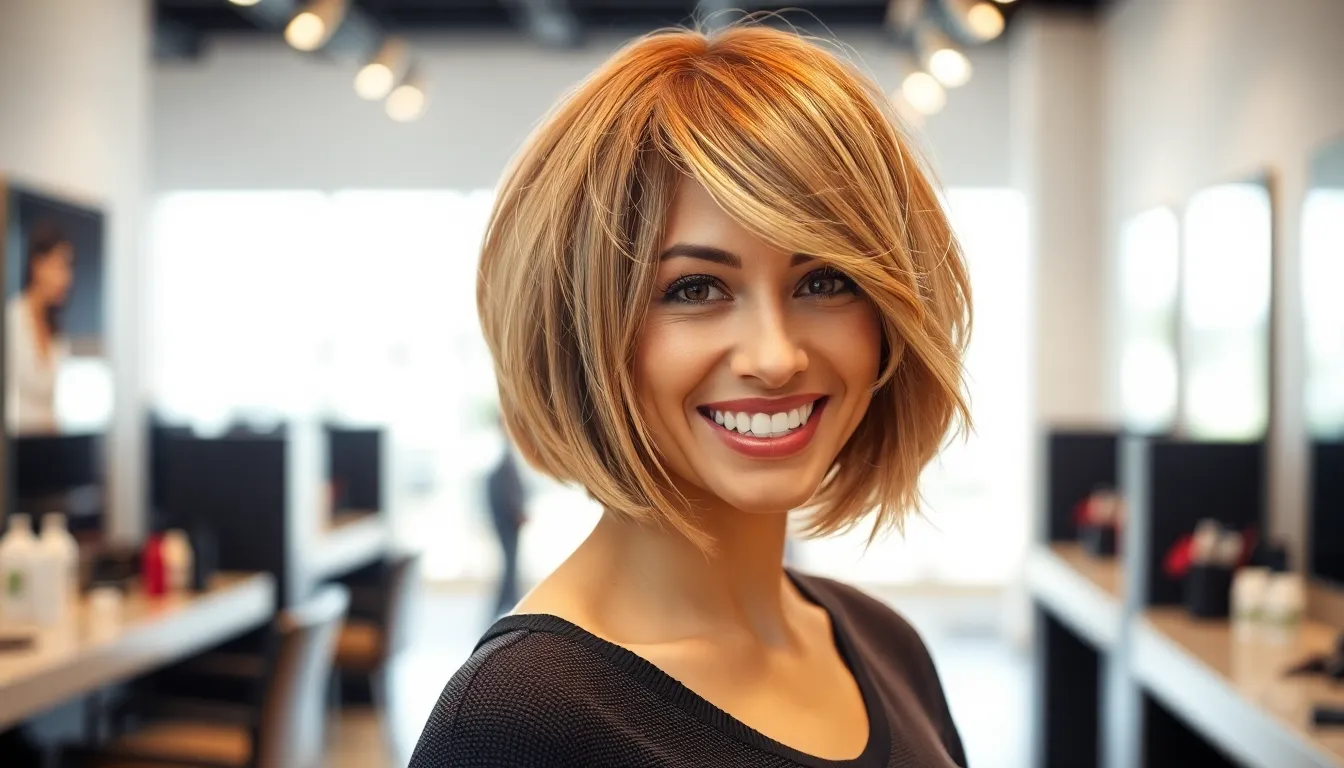
The inverted bob creates a powerful illusion of thickness through its strategic weight distribution, making it our top recommendation for fine hair. This cut features a shorter back that gradually lengthens toward the front, instantly adding visual volume where you need it most.
Why the Angled Cut Works for Thin Hair
Weight distribution becomes the key factor in creating fullness when we examine the inverted bob’s structure. The angled cut shifts hair weight from the bottom edges up to the root area, establishing a balanced foundation that makes fine strands appear substantially thicker.
Layering techniques starting at mid-shaft create texture that transforms flat, lifeless hair into ever-changing movement. We recommend this approach because it removes excess weight from the ends while maintaining enough bulk to create the appearance of density throughout the style.
Styling versatility allows for multiple looks that enhance volume naturally. Tousled finishes work particularly well with the inverted bob’s natural shape, while wavy textures can amplify the fullness effect even further.
Maintenance and Styling Requirements
Dry shampoo application at the roots provides instant texture and lift without weighing down delicate strands. We suggest using this product on second day hair to maximize volume potential and extend your style’s lifespan.
Heavy styling products should be avoided completely since they can flatten fine hair against the scalp. Light mousses and volumizing sprays work better for maintaining the inverted bob’s natural lift and movement.
Regular trimming schedules every 6-8 weeks keep the cut’s shape intact and prevent split ends from compromising the style’s fullness. Fresh cuts maintain the precise angles that create the illusion of thicker hair, making this maintenance step essential for optimal results.
Blunt Bob for Creating Thickness Illusion

Blunt bobs create one of the most effective illusions of thickness for fine hair by distributing weight evenly across straight, crisp ends. This strategic cut makes hair appear fuller and healthier than layered alternatives that can thin out delicate strands.
The Power of One-Length Cuts
One-length cuts deliver maximum impact for fine hair by maintaining every strand at the same level. Saoirse Ronan’s signature one-length bob demonstrates how this technique enhances the appearance of thickness through uniform weight distribution. French bobs and other one-length styles add volume and movement without sacrificing density.
Celebrities like Maude Apatow have showcased how blunt cuts create the illusion of thicker hair through their clean, straight edges. We recommend pairing one-length cuts with a middle parting to maximize the dramatic effect. Minimal layering works best with this style since it preserves the uniform look that creates visual thickness.
Color Techniques to Enhance Density
Multi-dimensional coloring adds depth and visual weight to fine hair blunt bobs. Darker tones create the illusion of density by adding shadows and dimension to the cut’s clean lines. Strategic highlights and lowlights can make each strand appear thicker by creating visual texture.
We suggest using deeper base colors with subtle variations rather than dramatic contrasts that might emphasize thinness. Rich browns, deep auburns, and dimensional brunettes work particularly well with blunt cuts. Color placement should follow the bob’s straight lines to maintain the style’s thickness improving properties rather than breaking up the uniform appearance that makes fine hair look fuller.
Wavy Bob With Beach Waves for Natural Movement

We find that wavy bobs with beach waves create the perfect illusion of natural movement while maximizing volume for fine hair. This style lifts the roots and adds body without weighing down delicate strands.
Adding Texture Without Weighing Hair Down
Graduated layers starting mid-shaft work best for creating texture in fine hair without sacrificing volume at the crown. We recommend asking your stylist to focus on sliced layers that begin halfway down the hair shaft rather than at the roots to maintain fullness where it matters most.
Strategic cutting techniques prevent flatness while building the appearance of thicker hair. Subtle graduation at the nape modernizes the look and eliminates any heavy or flat appearance that can plague fine hair types.
Undercuts add contemporary edge without compromising the overall volume of your wavy bob. These hidden details create movement and prevent the bottom section from appearing too bulky or weighed down.
Root preservation remains crucial throughout the layering process to maintain natural lift. We’ve found that keeping the crown area relatively untouched allows fine hair to achieve its maximum potential height and body.
Products That Enhance Fine Hair Waves
Volumizing mousses provide essential lift at the roots without the heaviness that can flatten fine strands. We apply these lightweight foams to damp hair before styling to create a strong foundation for beachy waves.
Salt sprays create definition for tousled textures while adding the grit necessary for wave formation. These products work particularly well on fine hair because they build texture without adding weight or creating buildup.
Texturizing sprays enhance wave patterns and increase overall volume when used with a diffuser during blow drying. We recommend applying these products section by section to amplify the natural wave formation.
Dry shampoo builds instant texture and lift at the crown between washes. This product is essential for maintaining the beachy wave look while preventing fine hair from falling flat throughout the day.
Heavy oils and creams should be avoided as they can instantly flatten fine hair and eliminate the natural movement that makes wavy bobs so effective. We stick to lightweight formulations that enhance rather than weigh down delicate strands.
A-Line Bob for Gradual Volume Building

This distinctive cut features shorter hair in the back that gradually lengthens toward the front, creating a natural volume distribution pattern. We recommend the A-line bob for fine hair because it removes excess weight from the ends while maintaining length where it’s most flattering.
Understanding the Graduated Cut
Graduated layers form the foundation of an effective A-line bob for fine hair. Starting these layers at mid-shaft creates movement and bounce without compromising the crown’s natural volume. Strategic layer placement removes weight from problem areas while preserving density where we need it most.
Texture emerges naturally when we incorporate graduated cutting techniques throughout the mid-lengths. These layers work differently than traditional uniform cuts by creating internal structure that supports volume. Weight distribution becomes more balanced as each layer builds upon the previous one.
Professional stylists typically begin graduated layers 2-3 inches below the crown area. This placement prevents the flat appearance that often plagues fine hair when layers start too high. Each successive layer should be slightly longer than the one above it to maintain the A-line’s signature silhouette.
Styling From Roots to Ends
Root preparation sets the stage for maximum A-line bob volume. We apply dry shampoo directly to the root area before styling to create instant texture and lift. This technique works especially well on day-old hair when natural oils provide additional grip for products.
Volumizing mousse distributed through damp mid-lengths creates the foundation for lasting body. Focus application from the ears down to avoid weighing down the crown area. Light formulations work better than heavy creams that can flatten fine strands.
Round brush blow-drying technique maximizes the A-line’s natural volume potential. Lift each section away from the scalp while directing airflow from roots to ends. This method creates tension that encourages hair to maintain its lifted position throughout the day.
Texturizing spray applied to dry hair enhances the graduated layers’ movement. Scrunch product into the ends to emphasize the A-line’s longer front sections. Light-hold hairspray sets the style without creating stiffness that can make fine hair look flat.
Shaggy Bob for Effortless Thickness
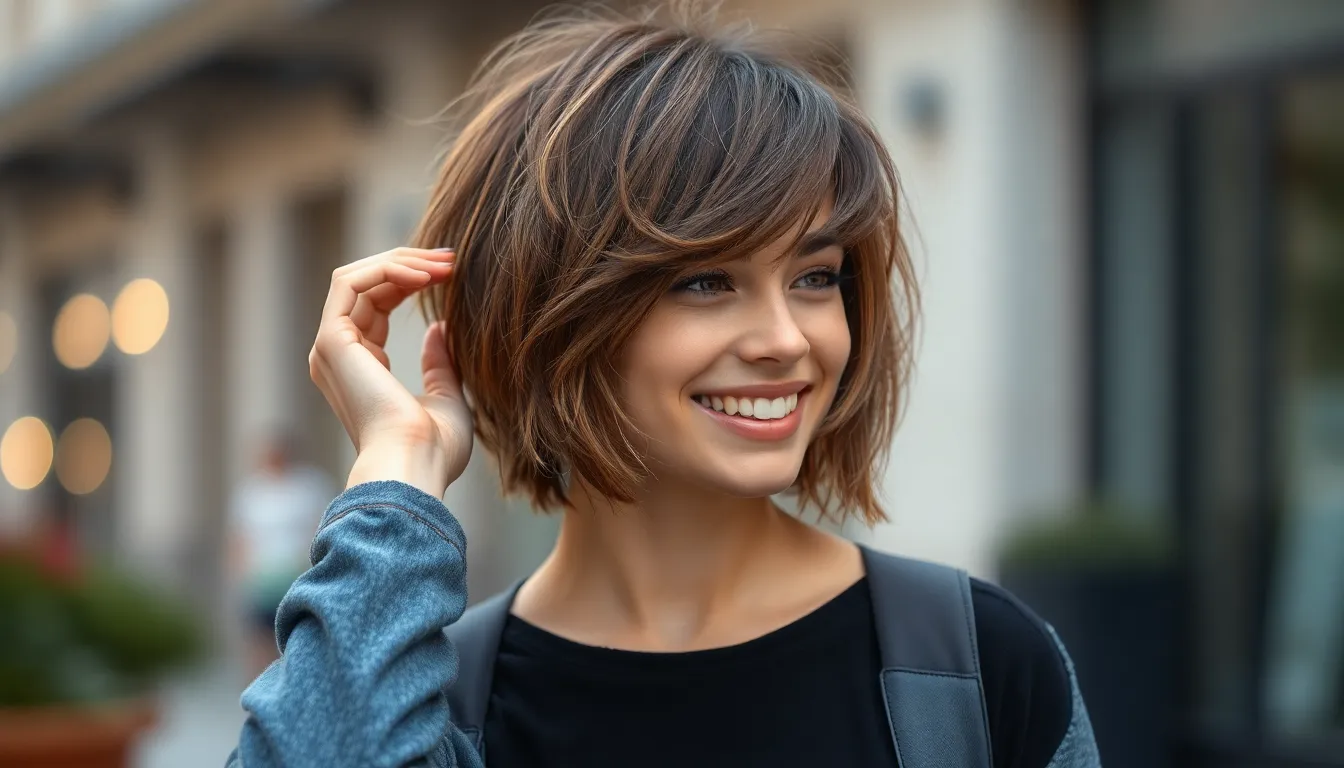
Choppy layers work differently than the graduated layers we’ve discussed, creating texture through deliberate unevenness rather than smooth transitions. This cutting technique transforms fine hair by adding visual weight through strategic placement of varying lengths.
Incorporating Choppy Layers Strategically
Layers starting mid-shaft and extending to the ends distribute weight evenly while creating a fuller appearance for fine strands. Strategic placement prevents the top section from appearing flat while maximizing volume where it’s needed most.
Different lengths throughout the hair create texture and movement that makes fine hair appear thicker than its actual density. We recommend keeping choppy layers concentrated in the lower two-thirds of the hair to maintain crown volume.
Enhanced movement comes from the varied cutting angles that allow individual sections to fall naturally at different points. This technique creates bounce and prevents fine hair from lying flat against the head.
Weight distribution becomes more balanced when choppy layers remove bulk from the ends while preserving density at the roots. Strategic cutting ensures that fine strands maintain their natural lift while gaining visual thickness.
Achieving the Perfect Undone Look
Styling with deliberate messiness creates a fuller appearance by adding texture and visual interest to fine hair. An undone finish makes choppy layers appear more voluminous through strategic tousling and product application.
Dry shampoo applied at the roots before styling provides instant texture and lift that enhances the shaggy bob’s natural movement. This technique creates grip for fine strands while adding the visual weight needed for thickness.
Texturizing products help achieve the perfectly imperfect finish that makes fine hair appear fuller and more ever-changing. Light application of sea salt spray or texturizing cream enhances the choppy layers without weighing down delicate strands.
Effortless finishing requires minimal heat styling to preserve the natural texture created by the choppy cutting technique. Air drying with scrunching motions enhances the undone look while maintaining volume at the crown.
Tousled movement comes from gentle finger combing through dried hair to separate the choppy layers and create additional texture. This final step ensures the shaggy bob maintains its thickness improving properties throughout the day.
Curly Bob for Fine Hair Transformation

We’ve discovered that curly bobs offer fine hair the perfect opportunity to add texture and create a fuller appearance while maintaining a stylish, modern look.
Creating Lasting Curls in Thin Hair
Preparation techniques form the foundation of successful curl retention in fine hair. We recommend starting with freshly washed hair using a lightweight volumizing shampoo to create the ideal base for curl formation. Applying curl defining creams while hair remains damp helps establish structure without weighing down delicate strands.
Strategic sectioning plays a crucial role in achieving uniform curls throughout your bob. We divide hair into 1 inch sections, working systematically from the bottom layer to the crown area. Taking smaller sections ensures each strand receives adequate attention and creates more defined curl patterns.
Setting techniques determine how long your curls will maintain their shape. We suggest allowing curls to cool completely in their formed position before gently separating them with fingers. This cooling process helps the hair cuticle close and lock in the curl pattern for extended wear.
Product layering enhances curl longevity without creating heaviness in fine hair. We apply a heat protectant first, followed by a lightweight mousse, and finish with a flexible hold gel. This combination provides structure while maintaining natural movement.
Heat-Free Styling Methods
Rag rolling transforms fine hair into beautiful curls overnight without heat damage. We wrap damp hair sections around fabric strips or old cotton t-shirts, securing them at the scalp. This gentle method creates soft, natural looking curls that add important volume to fine bob styles.
Twist and pin techniques offer versatility for creating various curl sizes and patterns. We twist small sections of damp hair into tight spirals, then pin them against the scalp using bobby pins. Leaving these twists in place for 4-6 hours or overnight produces defined curls with lasting hold.
Braiding methods create textured waves that enhance the appearance of thickness in fine hair. We suggest French braiding damp hair into 2-3 sections, sleeping on the braids, then gently separating the waves in the morning. This technique adds body and movement without the stress of heat styling.
Foam rollers provide another heat free option for achieving structured curls in bob length hair. We roll small sections of damp hair around foam rollers, securing them close to the scalp. The flexible foam allows comfortable sleeping while creating consistent curl patterns throughout your bob.
Curl improving creams work effectively on naturally wavy fine hair to amplify existing texture. We apply these products to damp hair using the scrunching method, encouraging natural curl formation. Air drying with periodic scrunching sessions produces enhanced waves with increased volume and definition.
Asymmetrical Bob for Modern Edge and Volume
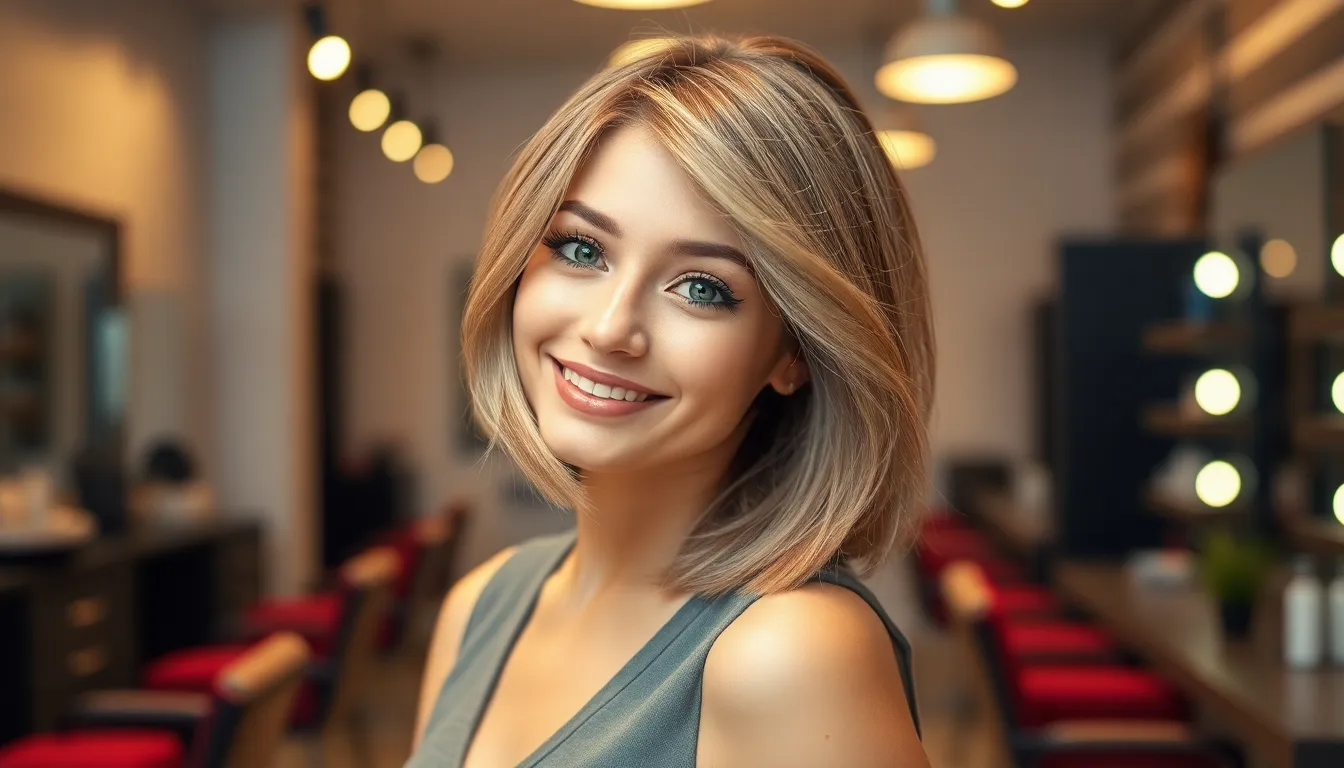
Asymmetrical bobs feature one side noticeably longer than the other, creating visual interest and modern sophistication. This uneven design prevents fine hair from lying flat while adding texture and movement that makes strands appear fuller.
Balancing Different Lengths Effectively
Keeping the back shorter adds crucial lift at the crown while preventing weight from pulling hair down. We recommend maintaining 2-3 inches of difference between the shorter and longer sides to create optimal visual balance without overwhelming fine strands.
Strategic graduation creates clean lines that maximize volume illusion throughout the cut. Sharp angles draw the eye along the hair’s shape, making density appear greater than it actually is. Stylists often incorporate subtle undercutting at the nape to further enhance fullness and prevent bulk at the neck area.
Layering techniques work best when applied sparingly to maintain the bob’s structural integrity. We suggest limiting layers to key areas where movement is needed most, typically around the face and at the longest points. This approach preserves weight distribution while adding the texture that fine hair craves.
Face Shape Considerations
Round faces benefit from asymmetrical bobs that hit below the jawline on the longer side. This placement creates vertical length that elongates facial features while the shorter side adds contemporary edge. We recommend angling the cut slightly forward to frame the face naturally.
Square faces look stunning with softer asymmetrical variations that curve gently around the jawline. The uneven lengths help break up angular features while maintaining the bob’s modern appeal. Adding face framing pieces on the longer side creates movement that softens strong jaw angles.
Heart shaped faces work beautifully with asymmetrical bobs that emphasize width at the jawline. We suggest keeping the longer side at chin level to balance a narrower chin with broader forehead proportions. The asymmetrical cut adds visual weight to the lower face while maintaining sophistication.
Oval faces can carry dramatic asymmetrical variations with confidence. These versatile face shapes support both subtle and bold length differences, allowing for creative expression through geometric lines and sharp angles that complement natural facial harmony.
Bob With Bangs for Added Density
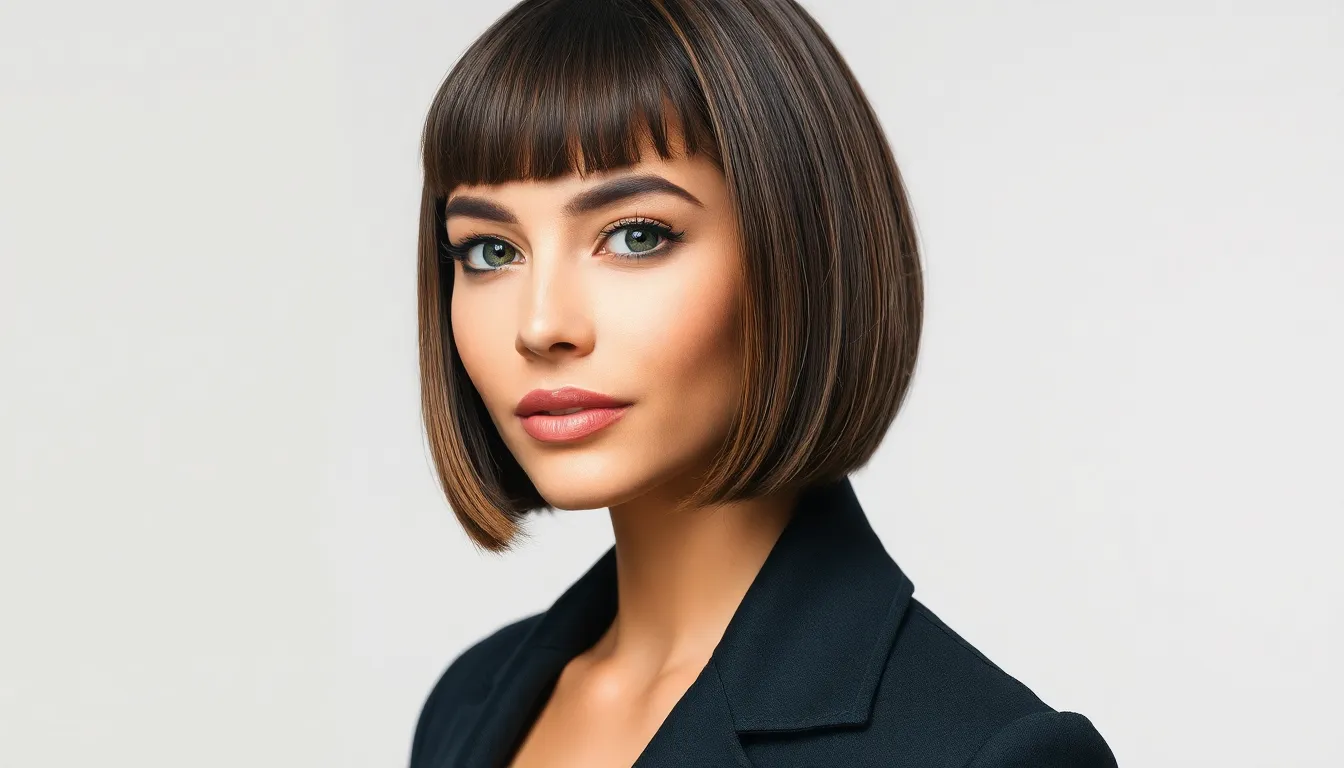
Adding bangs to your bob creates an instant illusion of thicker hair by strategically distributing visual weight around your face. This technique works particularly well for fine hair because it draws attention to your facial features while creating the appearance of denser strands.
Choosing the Right Bang Style
Blunt bangs deliver maximum impact for fine hair by creating a solid line of hair across your forehead. We recommend cutting them straight across at eyebrow level to establish a strong horizontal line that makes your hair appear thicker. This style works exceptionally well for most face shapes and provides a clean, polished appearance that complements bob cuts perfectly.
Side swept bangs offer a softer alternative that creates movement and texture without overwhelming fine strands. We suggest asking your stylist to cut them at an angle starting from your part line and sweeping across your forehead. This approach adds visual interest while maintaining a relaxed, effortless look that frames your face beautifully.
Wispy bangs provide subtle density enhancement for those who prefer a lighter touch. We recommend requesting feathered edges that blend seamlessly into your bob’s layers. This style creates texture without the commitment of heavier bang styles while still contributing to the overall fullness illusion.
Framing Your Face While Adding Fullness
Chin length bobs with bangs create perfect proportions by balancing the horizontal line of bangs with the bob’s hemline. We find this combination particularly effective for fine hair because it establishes two strong visual anchors that make your hair appear denser overall. The chin length cut sits just below your jawline while the bangs create a complementary frame above.
French bobs with bangs offer sophisticated elegance through their classic proportions and strategic length placement. We recommend this style for fine hair because the shorter length combined with bangs creates concentrated visual weight around your face. This combination sits just above your chin while the bangs typically fall at or slightly below your eyebrows.
Graduated bangs enhance the framing effect by creating multiple layers that add dimension and movement. We suggest incorporating subtle graduation within your bangs to mirror the layering in your bob cut. This technique creates visual continuity while maximizing the density improving benefits of both elements working together.
Styling Products That Enhance Fine Hair Bobs

We’ve found that the right products can make or break your fine hair bob, transforming limp strands into voluminous styles that last all day. These carefully selected formulas work specifically with fine hair’s unique characteristics to enhance your bob’s natural beauty.
Volumizing Mousses and Texturizing Sprays
Volumizing mousses create incredible lift and body when applied to damp hair before styling your bob. We recommend starting with a golf ball sized amount distributed evenly through your roots and mid lengths for maximum volume enhancement. These lightweight formulas add structure without weighing down delicate strands.
Texturizing sprays transform flat fine hair into dimensional masterpieces with just a few spritzes. We love applying these products to dry hair after styling to enhance your bob’s natural movement and create visual thickness. Salt based sprays work particularly well for adding grit and texture that makes fine hair appear fuller.
Combining both products creates the ultimate volume and texture duo for fine hair bobs. We suggest applying volumizing mousse first to damp hair, then finishing with texturizing spray once your style is complete. This layering technique maximizes both products’ benefits without creating heaviness.
Heat Protectants for Frequent Styling
Heat protectants shield fine hair from thermal damage while maintaining your bob’s healthy appearance through regular styling sessions. We always apply these products before using blow dryers, flat irons, or curling tools to prevent breakage and dryness. Fine hair requires extra protection since it’s more susceptible to heat damage than thicker textures.
Spray formulas distribute evenly through fine hair without adding unwanted weight or residue buildup. We prefer products with temperatures ratings up to 450°F that create an invisible barrier between your hair and styling tools. These formulations often include nourishing ingredients like keratin and silk proteins that strengthen fine strands.
Leave in heat protectants double as styling aids, providing both thermal protection and light hold for your bob. We find these multi tasking products especially valuable for fine hair since they eliminate the need for multiple heavy products. Regular use maintains your bob’s integrity while supporting healthy hair growth and shine.
Conclusion
Finding the perfect bob for fine hair doesn’t have to be a challenge when you know which cuts work best. We’ve shown you that with the right techniques and strategic styling choices you can achieve incredible volume and movement that transforms your look completely.
The key lies in understanding how different bob variations work with your hair’s natural texture. Whether you choose a textured lob inverted cut or asymmetrical style each option offers unique benefits that enhance fine hair’s appearance.
Remember that the right products make all the difference in maintaining your bob’s fullness and definition. With lightweight volumizers texturizing sprays and proper styling techniques you’ll keep your fine hair looking thick vibrant and beautifully styled every day.
Frequently Asked Questions
What makes a bob haircut good for fine hair?
Bob haircuts are excellent for fine hair because they create the illusion of thickness through strategic weight distribution and layering. The concentrated weight at the ends makes hair appear fuller, while various bob styles like inverted, blunt, and textured bobs can add volume and movement that fine hair typically lacks.
How should layers be placed in a bob for fine hair?
Layers should start 2-3 inches from the crown to avoid flatness at the root area. Use long layers for movement while maintaining weight, and limit layers to 2-3 distinct levels to prevent fine strands from appearing thinner. Face-framing pieces add dimension without sacrificing overall volume.
What’s the difference between an inverted bob and a regular bob?
An inverted bob features a shorter back that gradually lengthens toward the front, creating strategic weight distribution for maximum volume. This angled cut shifts hair weight from bottom edges to the root area, making fine hair appear thicker compared to a regular bob’s uniform length.
Can fine hair handle textured and wavy bob styles?
Yes, textured and wavy bobs work exceptionally well for fine hair. Beach waves create natural movement and maximize volume, while graduated layers starting mid-shaft add texture without sacrificing crown volume. These styles enhance the appearance of thickness through increased dimension and movement.
What styling products work best for fine hair bobs?
Use lightweight volumizing mousses, texturizing sprays, and dry shampoo at the roots for lift and definition. Avoid heavy oils and creams that can flatten fine hair. Heat protectants are essential, but choose lightweight formulas that protect without adding weight to maintain the bob’s natural volume.
How often should fine hair bobs be trimmed?
Fine hair bobs should be trimmed every 6-8 weeks to maintain their shape and prevent split ends. Regular maintenance preserves the cut’s fullness and ensures the strategic weight distribution that creates the illusion of thickness remains intact for optimal styling results.
Do bangs work well with bob haircuts for fine hair?
Yes, bangs complement bob haircuts beautifully for fine hair. Blunt bangs create maximum impact, side-swept bangs offer a softer look, and wispy bangs provide a lighter touch. Bangs add visual weight and help frame the face while enhancing the overall appearance of thickness.
What’s the best way to style an asymmetrical bob for fine hair?
Maintain a 2-3 inch difference between lengths for optimal visual balance. Use strategic graduation to enhance volume illusion and apply layers sparingly to maintain structure. Style with volumizing products and focus on root lift to prevent the longer side from appearing flat.
